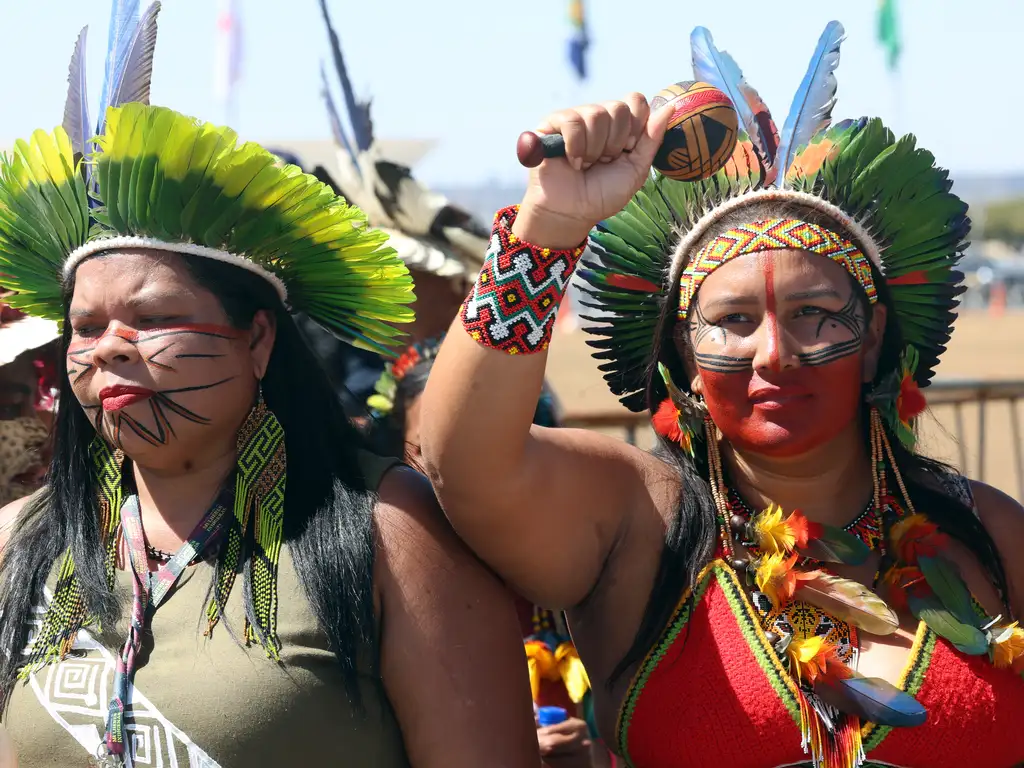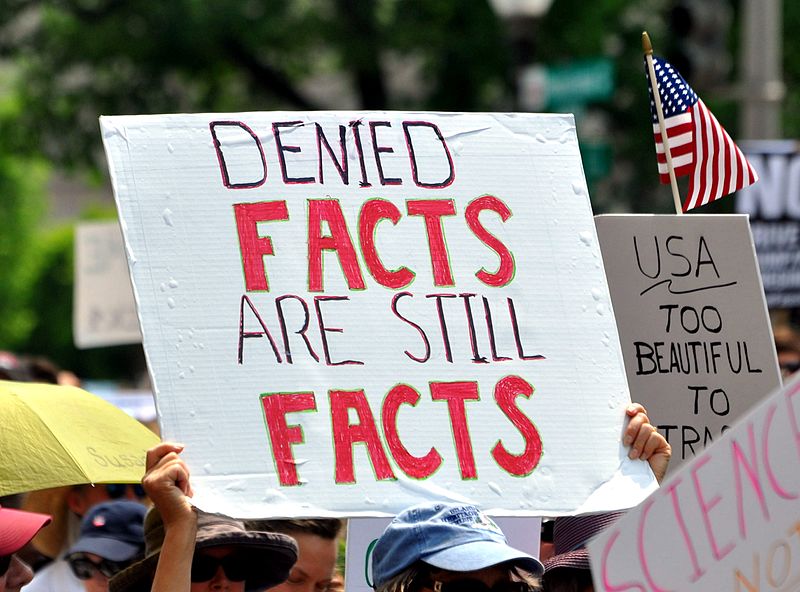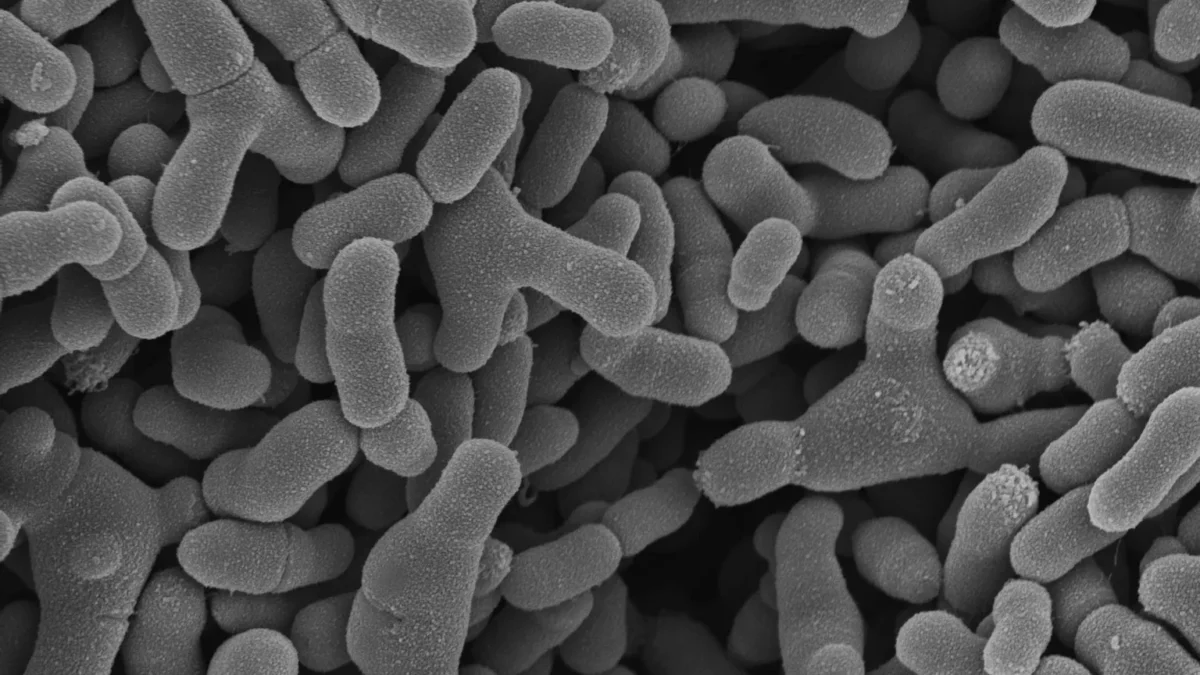 #News
#News
Scientific truth: The journey to consensus
Explaining that scientific facts do not “fall from the sky,” but are the result of a complex process of constructing knowledge, must be part of the fight against denialism, say researchers
 Sign at a climate change rally in the United States: “Denied facts are still facts.” It took many years of observation and analysis—and more than 90,000 published scientific articles—before scientists reached a consensus that human activities are altering the Earth’s climate | Image: Wikimedia Commons
Sign at a climate change rally in the United States: “Denied facts are still facts.” It took many years of observation and analysis—and more than 90,000 published scientific articles—before scientists reached a consensus that human activities are altering the Earth’s climate | Image: Wikimedia Commons
In ancient Greece, the Oracle of Delphi never answered the same question twice. In this way, she never had to change her mind. Scientists, on the other hand, question themselves—and are questioned—almost every day. And their explanations of nature tend to change as they collect and analyze new data and incorporate new observations and evidence into their research. Scientific truth is not absolute, but temporary and incomplete. More like Heraclitus’s flowing river than Plato’s eternal forms.
This and other basic principles of conducting science seemed to be well established. In recent years, however, they have been hijacked by organized groups and individuals with conflicting political or economic beliefs or interests, or simply low levels of literacy, to spread false—or deliberately distorted—information and conspiracy theories.
The purpose? To attack and discredit science, and to spread distrust and contempt for scientific thought, opposing evidence and consensus on topics such as climate change and the theory of evolution.
This phenomenon intensified during the pandemic, with the spread of anti-vaccine movements on digital platforms and the institutionalization of denialist governments in several countries, including Brazil. According to some scholars, these movements tend to gain momentum in polarized societies that are unaware of what science is and how it works.
“It is important to make it clear that science is not a shelf of ready-made results and magical products,” says Alexandre Meyer Luz, a Theory of Knowledge professor at the Federal University of Santa Catarina’s Philosophy Department (UFSC).
He explains that science is a slow and complex process, and that what is well established at one point in time may be provisional at another, susceptible to being overturned or reformulated in the light of new observations.
Modern science can be understood as a set of methods that allow us to identify patterns behind natural, social, and behavioral phenomena and describe them using general laws.
Human interest in describing, explaining, predicting, and intervening in the world is as old as humanity itself.
We have long sought to understand nature and use this knowledge to further our interests: sailing the seas, domesticating and modifying plants for agriculture, fighting diseases, etc.
Methods for studying nature evolved following the scientific revolution in the sixteenth and seventeenth centuries. Scientists increasingly relied on observation, systematic experimentation, and inductive reasoning to challenge their own and others’ findings—quite a change from the Aristotelian emphasis on deductive reasoning based on supposedly known facts.
Science follows common principles
Whatever the field, scientists today still follow common principles to develop their research: they start with new ideas or evidence from the past, collect and analyze data, and develop hypotheses about possible connections or patterns in nature.
“Whenever a new problem of a scientific nature arises, they turn to what has been produced in the past to guide their investigations, often replicating previous experiments to lay the foundations for new hypotheses,” explains philosopher of science Ivan Ferreira da Cunha, from the UFSC Philosophy Department.
Although these principles are common to all fields of knowledge, different disciplines use specific tools and approaches to study phenomena and systems specific to each field.
However, in order for research findings to become scientific truth, they must first pass the scrutiny of other researchers in the same field and be published in a scientific journal in the form of a scientific article.
In this process, known as peer review, two or three experts appointed by the journal assess the validity of what the authors describe in the manuscript.
They analyze:
- Whether the research methodology makes sense;
- Whether the necessary experiments have been carried out satisfactorily;
- Whether the results obtained support the conclusions presented.
The reviewers can also:
- Request additional information from the authors;
- Suggest additional experiments;
- Ask for clarification, always based on evidence, testing hypotheses, and looking for falsehoods in other people’s ideas—a principle proposed in 1934 by philosopher of science Karl Popper (1902–1994) in The Logic of Scientific Discovery.
If the reviewers are convinced of the work’s validity, they recommend that the journal’s editor accept the article for publication. This helps ensure that published articles are based on well-designed research, with robust methodology and sound data.

Often, seemingly promising findings are not confirmed when other scientists try to reproduce them in their laboratories. This can happen for a number of reasons, including error, fraud, and lack of transparency about the primary data and methods used in the original research.
In these cases, the explanations or ideas presented in the original article are questioned or even rejected. Some propose new hypotheses or alternative explanations. The original author may test them or provide additional evidence to support their claims.
“It’s a self-correcting mechanism for science,” says Cunha, from UFSC. “The end goal is not to disagree with or discredit colleagues, but to review their findings and methods so that the scientific community can reach a consensus on the validity of a given discovery and explanation.”
Months passed since the first case of Zika in Brazil before the scientific community reached a consensus that the virus was behind some of the microcephaly cases identified in the country.
First, it was found that the pathogen was able to cross the human placenta—the organ that connects the fetus to the mother’s body during pregnancy. The virus was then isolated from the brains of babies with microcephaly. Laboratory experiments carried out by groups in Brazil and abroad then showed that the virus could infect and kill human precursor cells in the central nervous system.
In May 2016, Brazilian researchers published a study showing that the strain of the virus circulating in Brazil (ZIKVBR) was more aggressive than the African strain.
This strain was able to cross the placenta of female mice with weakened immune systems and impair the development of the pups, which were born small and weighing less than half their normal weight. They also had smaller brains than healthy pups.
Similarly, it took many years of observation and analysis—and more than 90,000 published scientific articles—before scientists reached a consensus that human activities are altering the Earth’s climate.
Campaigns to discredit
During the COVID-19 pandemic, researchers all over the world had to rush to develop a safe and effective strategy against the novel coronavirus. A lot of work was done hastily and without the usual scientific rigor.
Some resonated strongly on social media, supporting unsubstantiated claims about supposed treatments for the disease and discursive strategies—such as scientific authority—to try to legitimize the dissemination of false information or to counter scientists with pseudo-scientific arguments, almost always claiming a different interpretation.
“Often, the dynamics of scientific knowledge production are used to reinforce the idea that scientific truth, because it is temporary and incomplete, may be wrong; therefore, my opinion may be right,” says Meyer Luz. “This is poor education in science and philosophy.”
Various science communication initiatives have been created to address this problem, many of which are based on the idea of explaining basic scientific concepts and how science works to society.
The problem, according to biologist and science communicator Ana de Medeiros Arnt, from the Biology Institute of the University of Campinas (UNICAMP), is that many “anti-science” rallies are not challenging science as such.
These events invest in discursively deconstructing scientific credibility with the aim of defending or reaffirming economic, political, and religious interests. “In these cases, any attempt to bring the scientific method into the debate is innocuous,” says Arnt.
According to Rafael Evangelista, a sociologist at UNICAMP’s Creativity Development Center, these initiatives are valid but insufficient because they assume that people are always rational and that there is a lack of scientific information in society. According to him, the problem goes beyond this.
It conflicts with the business model employed by digital platforms, which is essentially based on promoting friction between groups with opposing views in order to generate more engagement.
“Content that is divisive, hateful, and of dubious origin tends to generate more comments and shares,” explains Evangelista. “Facebook realized this some time ago and adjusted its algorithm to offer this type of content to more and more people.”
The researcher explains that platforms are able to capture more data from users through viral content, which also makes them spend more time on social networks producing more content.
“We need to invest in science communication and media education initiatives that explain what science is and how scientific knowledge is constructed,” suggests Evangelista.
“However, this needs to be accompanied by regulations imposed on digital platforms. Otherwise, we’ll continue beating a dead horse.”
*
This article may be republished online under the CC-BY-NC-ND Creative Commons license.
The text must not be edited and the author(s) and source (Science Arena) must be credited.
News
 #News
#News
 #News
#News
 #News
#News
